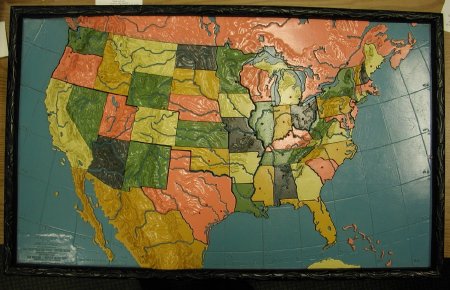Object ID:
2005.56
Title:
Small dissected relief map of U.S.
Creator:
Butler, William J.
Description:
Molded dissected relief map of Continental United States; pieces are handpainted in bright shades of yellow, gold, green, gray, and pink; rivers and other bodies of water are depressed and enameled blue; cities are indicated by nailheads, capitol cities are enameled red, other cities black; Canada, Mexico, and Caribean islands are fixed; longitude and latitude lines are depressed on Ocean areas and their positions west of Greenwich and north of the Equator noted in braille; molded black frame and back; composite material resembles masonite.
Dimensions:
H-19.5 W-31.5 D-1.125 inches
Date:
ca. 1965
Made by:
American Printing House for the Blind
Place of Origin:
Louisville, KY
Provenance:
APH Superintendent Benjamin Huntoon began making wooden relief maps in the basement of the Ky. School for the Blind in the 1870s. Little changed in their manufacture for fifty years. In the 1922, APH bought electric carving tools to speed the process, but the manufacture of the maps continued to require skill and tedious handwork. In 1936, an article in the Courier Journal featured an interview with the foreman of the APH map shop, William J. Butler, who was working on a wooden model of a U.S. map to be used to "make a mold for experiments in compositions." The copyright date on the mold (see 1992.267.2) of 1939 suggests the experiments were completed by that date. Production of dissected maps almost doubled in the years between 1938 and 1944, reaching levels not seen again until the mid 1960s. By 1945, the desk-sized hard rubber relief map of the U.S. appeared in the APH catalog. A 1945 report on map work for the AAIB by Mrs. Hugh D. Johnson praised the APH dissected relief maps in general as the "ones most eagerly used by teachers and children alike," and in specific "the special delight of all my classes is the desk sized hard rubber relief map…" In the mid 1960s, APH began making the desk map from plastic. Former Educational Aids employee Ron Gadson described the process as the mixing of liquid with a powdered binder, which resulted in the brown color. This version last appeared in the APH catalog in 1986. A U.S. puzzle map of different design was reintroduced in 2002.
Credit Line:
Museum Purchase, 2005.56
